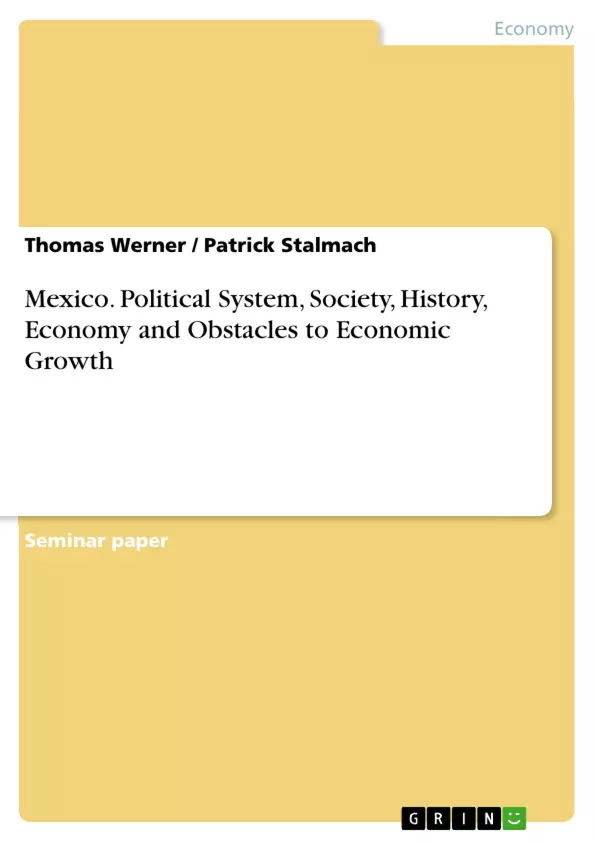Mexico, the second largest economy in Latin America, finds itself confronted with several internal and external issues. In the prior year, the country experienced a decline of the economic growth. Major reasons are on the one hand, the uncertain future after the presidential election of Donald Trump, as well as the decreasing industrial production of the main trade partner, the USA. In consequence, the oil price fell, and the Mexican currency lost 20% of their value. On the other hand, the domestic market is strongly influenced by misallocation of educational funds, failed reforms, which increased the income inequality and organized crime. This essay will reflect briefly on these topics, to give a short overview of the country`s economic background andthe current situation. Furthermore, certain information about society, history and the political system will be provided to allow the reader a full insight into these connected topics.
Table of Contents
- 1. Introduction
- 2. Overview
- 3. History
- 4. Political System
- 5. Society
- 6. Economic growth
- 7. Obstacles for the economic growth
- 8. Conclusion
Objectives and Key Themes
This essay aims to provide a concise overview of Mexico's economic background and current situation. It briefly touches upon the internal and external challenges facing Mexico's economy, including the impact of global events and domestic issues. The essay also offers context by providing information on Mexican society, history, and political systems.
- Mexico's economic challenges
- The impact of global events on the Mexican economy
- Domestic factors influencing the Mexican economy
- An overview of Mexican society
- A brief look at Mexican history and the political system
Chapter Summaries
1. Introduction: This introductory chapter sets the stage by highlighting Mexico's position as Latin America's second-largest economy and its current struggle with various internal and external issues. It emphasizes the recent economic downturn, attributing it to factors such as uncertainty following the Trump presidential election, decreased industrial production from the US (Mexico's main trading partner), falling oil prices, and a 20% devaluation of the Mexican currency. Domestically, the chapter points to misallocation of educational resources, failed reforms increasing income inequality, and organized crime as significant contributors to the economic challenges.
2. Overview: This chapter presents a geographical and demographic overview of Mexico, describing its location, size, and population. It highlights Mexico's diverse climate zones, which allow for year-round cultivation of tropical fruits and vegetables. The chapter also underscores Mexico's rich biodiversity and significant tourism potential, emphasizing its beautiful beaches, ancient ruins, and varied landscapes.
3. History: This chapter delves into Mexico's rich history, focusing on the Mayan and Aztec civilizations. It describes the achievements of the Mayan civilization, including their advancements in calendar systems, writing, art, architecture, mathematics, and astronomy, and discusses their eventual decline likely due to overpopulation and ecological damage. The chapter then recounts the rise of the Aztec empire, their conquest of neighboring cultures, and their eventual defeat by Hernán Cortés in 1521, leading to the Spanish colonization of Nueva España. The chapter further highlights the devastating impact of diseases brought by the Spanish, which resulted in the death of millions of indigenous people.
Keywords
Mexico, economy, economic growth, political system, society, history, Mayan civilization, Aztec civilization, global events, domestic issues, income inequality, organized crime, tourism, economic challenges.
Frequently Asked Questions: Mexico's Economic Background and Current Situation
What is the purpose of this document?
This document provides a comprehensive language preview of an essay about Mexico's economy. It includes a table of contents, objectives and key themes, chapter summaries, and keywords. The purpose is to offer a structured overview of the essay's content for academic use, facilitating the analysis of its themes.
What topics are covered in the essay?
The essay covers Mexico's economic challenges, the impact of global and domestic factors on its economy, an overview of Mexican society, and a brief look at its history and political system. Specific topics include the impact of events like the Trump election and falling oil prices, domestic issues like income inequality and organized crime, and historical context from Mayan and Aztec civilizations to Spanish colonization.
What are the key themes of the essay?
Key themes include Mexico's economic challenges, both internal and external; the influence of global events (e.g., the Trump presidency, falling oil prices) and domestic issues (e.g., income inequality, organized crime) on the Mexican economy; and the historical and societal context shaping Mexico's economic situation.
What is covered in the introduction chapter?
The introduction highlights Mexico's status as Latin America's second-largest economy and its current economic struggles. It points to factors contributing to a recent downturn, including uncertainty following the Trump election, decreased US industrial production, falling oil prices, currency devaluation, misallocation of educational resources, failed reforms increasing income inequality, and organized crime.
What is covered in the overview chapter?
This chapter provides a geographical and demographic overview of Mexico, including its location, size, population, climate zones, biodiversity, and tourism potential.
What is covered in the history chapter?
The history chapter explores the Mayan and Aztec civilizations, detailing their achievements and decline (Mayans) and the rise and fall of the Aztec Empire, culminating in the Spanish conquest and its devastating impact on the indigenous population.
What are the key words associated with this essay?
Keywords include Mexico, economy, economic growth, political system, society, history, Mayan civilization, Aztec civilization, global events, domestic issues, income inequality, organized crime, tourism, and economic challenges.
What is the overall scope of the essay?
The essay aims to provide a concise overview of Mexico's economic background and current situation, connecting its economic challenges to its history, society, and political system, and highlighting both internal and external factors.
- Quote paper
- Thomas Werner (Author), Patrick Stalmach (Author), 2017, Mexico. Political System, Society, History, Economy and Obstacles to Economic Growth, Munich, GRIN Verlag, https://www.grin.com/document/428162



